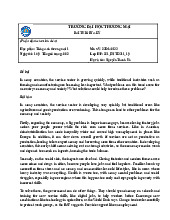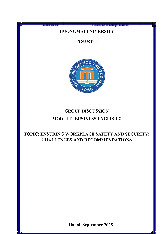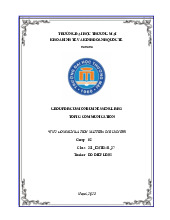











Preview text:
lOMoAR cPSD| 47207194
TRƯỜNG ĐẠI HỌC THƯƠNG MẠI
KHOA KINH TẾ VÀ KINH DOANH QUỐC TẾ --- ---
BÀI THẢO LUẬN
Học phần: Tiếng Anh Thương Mại 1
Mã lớp học phần: 242_ENTI3311_25
ĐỀ TÀI : How e-commerce changes consumer habits in Vietnam
Thực hiện: Nhóm 3
Giảng viên: ThS. Vũ Thị Thu Trang
Hà Nội, năm 202 5 1 lOMoAR cPSD| 47207194
BẢNG PHÂN CÔNG NHIỆM VỤ VÀ ĐÁNH GIÁ THÀNH VIÊN Họ và tên Phân công nhiệm vụ Đánh giá Đinh Nguyễn Hải Đăng -Nội dung phần 2.5: (nhóm trưởng) Solution/Suggestion Phan Thu Hà - Nội dung phần 2.3: Disadvantages Trần Bảo Hà -Introduction - Nội dung phần 2.1.1 và 2.1.2 - Chỉnh sửa Word Đào Thị Bằng Giang - Nội dung phần 2.2: Situation Phan Hải Đăng - Nội dung phần 2.1.3 - Conclusion -Powerpoint Nguyễn Thái Hà - Nội dung phần 2.4: Advantages Nguyễn Trường Giang Nội dung phần 2.2: Development Process Nguyễn Thuỳ Dương Nội dung phần 2.2: Development Process TABLE OF CONTENTS
I. INTRODUCTION........................................................................................................
II. MAIN CONTENTS.....................................................................................................
2.1. Concepts.............................................................................................................. 2.1.1.
The definition of E-
commerce...................................................................... 2.1.2. Types of E-
commerce.................................................................................... 2.1.3. The role of
E-commerce................................................................................ 2.2.
The situation and the development of E-commerce in Vietnam...................... 2.2.1.
Situation of E – Commerce in
Vietnam........................................................ 2.2.2.
The development of E – 2 lOMoAR cPSD| 47207194
Commerce in Vietnam........................................... 2.3. Advantages of e-commerce
for consumer habits in VietNam.............................
2.3.1. Saving time........................................................................................................
2.3.2. Competitive pricing and discounts...................................................................
2.3.3. Wider product selection..................................................................................
2.4. Disadvantages of E-commerce’s Influence on Consumer Habits.....................
2.4.1. Over-Reliance on Algorithms and Data Privacy Concerns...........................
2.4.2. Impersonal and Overwhelming Digital Communication...............................
2.4.3. Rising Cybersecurity Threats and Fraud Risks.............................................
2.5. Suggestions to Elevate Customer Experience and Satisfaction in
Vietnamese E-commerce.............................................................................................
2.5.1. Hyper-Personalization for Relevant Shopping Experiences in Vietnam.......
2.5.2. Proactive and Instant Customer Communication in Vietnam.......................
2.5.3. Building Trust and Security in Every Interaction in Vietnam......................
2.5.4. Value-Driven and Delightful Offers & Rewards in Vietnam......................... III.
CONCLUSION..................................................................................................... I. INTRODUCTION
In recent years, e-commerce has dramatically transformed the way Vietnamese
consumers shop, reshaping traditional buying behaviors and redefining market trends.
With the rapid growth of digital technology, increasing internet penetration, and the
widespread use of smartphones, online shopping has become a preferred choice for
many Vietnamese consumers. Platforms like Shopee, Lazada, Tiki, and Sendo have
revolutionized the retail landscape, offering convenience, competitive pricing, and a diverse range of products.
Vietnam's e-commerce sector has experienced remarkable growth, solidifying its
position as a key driver of the nation's digital economy. In 2024, the market surpassed
$25 billion in revenue, marking a 20% increase from the previous year and accounting
for approximately 9% of the country's total retail sales and consumer service revenue.
One of the most significant changes in consumer habits is the shift from in-store
shopping to online purchases. Traditionally, Vietnamese shoppers relied on physical
markets and brick-and-mortar stores, where they could inspect products before buying.
However, with the advent of e-commerce, consumers now enjoy the convenience of
shopping anytime, anywhere, without the need to visit stores physically. This shift is
particularly noticeable in urban areas, where busy lifestyles and improved logistics have
fueled the demand for online shopping.
E-commerce has also influenced consumer decision-making processes. Online reviews,
ratings, and social media recommendations now play a crucial role in shaping
purchasing choices. Consumers are more informed than ever, comparing prices and
researching products before making a decision. Additionally, flash sales, discount codes, 3 lOMoAR cPSD| 47207194
and promotional campaigns on e-commerce platforms have encouraged impulsive
buying behavior, further driving online sales.
Moreover, digital payment solutions such as e-wallets (Momo, ZaloPay, VNPay) and
cashless transactions have gained popularity, reducing reliance on cash and making
online shopping more seamless. The rise of e-commerce has also given small businesses
and individual sellers new opportunities to reach a broader audience, fostering
entrepreneurship and economic growth.
Our presentation is divided into 5 parts: 1. Definition of e-commerce 2. Types of e-commerce
3. Advantages of e-commerce for business
4. Disadvantages of e-commerce for business 5. Conclusion II. MAIN CONTENTS 2.1. Concepts
2.1.1. The definition of E-commerce. -
Ecommerce or "electronic commerce" is the trading of goods and services
online.Ecommerce is when individuals and companies buy or sell goods and services
over the internet. Ecommerce can happen through a website, smartphone app, social
media platform, online marketplace, or other sales platform. -
Common examples of ecommerce include online shopping, electronic
payments,online auctions, and internet banking. You can participate in e-commerce
anywhere with an internet connection. The goal of ecommerce for a seller is to drive
sales using digital platforms and marketing strategies. -
Some businesses sell exclusively online or use ecommerce to expand the reach
oftheir other distribution channels. Either way, ecommerce is thriving and can be a profitable venture.
2.1.2. Types of E-commerce.
There are six fundamental types of e-commerce: Business-to-Business (B2B), Business-
to- Consumer (B2C), Consumer-to-Consumer (C2C), Consumer-to-Business (C2B),
Business-to-Administration (B2A) and Consumer-to-Administration (C2A). Each of
these categories signifies a distinct purchasing dynamic.
2.1.2.1. Business-to-Business (B2B):
B2B encompasses all electronic transactions of goods or services conducted between
companies. Producers and traditional commerce wholesalers typically operate with this type of electronic commerce.
2.1.2.2. Business-to-Consumer (B2C): 4 lOMoAR cPSD| 47207194
It relates to relationships between businesses and final consumers. This type of
commerce has developed greatly, due to the advent of the web, and there are already
many virtual stores and malls on the Internet, which sell all kinds of consumer goods,
such as computers, software, books, shoes, cars, food, financial products, …When
compared to buying retail in traditional commerce, the consumer usually has more
information available in terms of informative content and there is also a widespread idea
that you’ll be buying cheaper, without jeopardizing an equally personalized customer
service, as well as ensuring quick processing and delivery of your order.
2.1.2.3. Consumer-to-Business (C2B):
In C2B there is a complete reversal of the traditional sense of exchanging goods. This
type of e-commerce is very common in crowdsourcing-based projects. A large number
of individuals make their services or products available for purchase for companies
seeking precisely these types of services or products.
2.1.2.4. Consumer-to-Consumer (C2C):
Consumer-to-Consumer (C2C) type e-commerce contains all electronic transactions of
goods or services conducted between consumers. Generally, these transactions are
conducted through a third party, which provides the online platform where the
transactions are actually carried out.
2.1.2.5. Business-to-Administration (B2A):
This part of e-commerce includes all transactions conducted online between companies
and public administration. This is an area that involves a large amount and a variety of
services, particularly in areas such as social security, employment, legal documents, etc.
These types of services have increased considerably in recent years with investments
made in e-government. 2.1.2.6. Consumer-to-Administration (C2A):
The Consumer-to-Administration model embraces all electronic transactions conducted
between individuals and public administration.
Examples of applications include: •
Education – disseminating information, distance learning, etc. •
Social Security – through the distribution of information, making payments, etc.
Taxes – filing tax returns, payments, etc. •
Health – appointments, information about illnesses, payment of health services, etc.
Both models involving Public Administration (B2A and C2A) are strongly associated
with the idea of efficiency and easy usability of the services provided to citizens by the
government, with the support of information and communication technologies.
2.1.3. The role of E-commerce
Electronic commerce has become a critical element of modern business, transforming
the interface between businesses and consumers by dramatically reducing transaction
costs and overall efficiency. Among the most significant advantages is the reduction in 5 lOMoAR cPSD| 47207194
search costs. Under the traditional supply chains, customers often had to travel through
a series of intermediaries to gain information about suppliers, products, and prices, a
time- and money-consuming exercise. E-commerce facilitates this process with ease by
providing instant access to a vast amount of information on the internet, allowing buyers
to make more informed decisions with lesser effort, time, and cost. Such efficiency is
further enhanced by automating transactional processes, such as invoices and purchase
orders, which speed up processes and reduce errors.
Another significant benefit of e-commerce is disintermediation, whereby consumers and
suppliers can directly interact and exchange without the presence of middlemen. This
eliminates the costs and delays associated with middlemen, which were typically a
significant factor in traditional business models. Though new forms of intermediaries
like e-markets have been developed, the latter allow simpler transactions rather than
making them complex by bringing buyers and sellers together in a clearer environment.
Direct access allows for faster and lower-priced transactions that end up benefiting both parties.
E-commerce also serves to promote price transparency, which is perhaps one of the most
glaring advantages of online markets. By concentrating a large number of buyers and
sellers into one market, e-commerce exposes market prices and transaction facts in real
time, so it makes these topics of public information for all its users. It facilitates buyers'
price comparison and being better-informed buyers and thereby opening up a more
competitive market. More price transparency supports lessening of price differences to
drive companies into offering better prices and deals, eventually benefiting the consumer.
As a general principle, e-commerce has reshaped the business environment via reduced
costs in transactions, simplified procedures, and greater visibility for markets. Via giving
purchasers better information and supporting direct connection among consumers and
providers, e-commerce has enhanced new trade to make it more competitive, efficient, and inclusive of all players.
2.2. The situation and the development of E-commerce in Vietnam
2.2.1. Situation of E – Commerce in Vietnam
In recent years, Vietnam’s E – Commerce market has experienced rapid growth,
surpassing $25 billion in 2024, a 20% increase compared to 2023, with an annual growth
rate of 18 – 25% and becoming a key sector in the digital economy. This surge is fueled
by increasing smartphone penetration and the rising middle class that favors online
shopping. Dominated by major players such as Shopee, Tiktok Shop, and other
platforms. However, challenges remain including regulatory gaps, issues with
counterfeit products, and compliance hurdles for international players which have
prompted the government to consider new legal frameworks to better safeguard
consumers and ensure sustainable market development. Overall, Vietnam continues to
evolve as a dynamic hub for digital commerce in Southeast Asia, balancing significant
growth with the need for enhanced regulatory oversight.
Some popular E – Commerce in Vietnam: 6 lOMoAR cPSD| 47207194
There’s no doubt that nowadays E – Commerce is a global trend since it facilitates people
around the world to get everything they need with a click. The rising trend is spreading
out in Vietnam, too. We cannot deny that there are hundreds of Vietnam E – Commerce
platforms operating on different scales and structures.
First, Shopee is on the top of the list. It can be seen as the Vietnamese E – Commerce
website most visited by consumers. The main reason for a new company to have an amazing record comes from:
Shopee's online layout is incredibly user – friendly, easy to use, and quick order
processing is just a few of the great features that have helped Shopee become Vietnam's
no.1 E – Commerce website at the current time. To be honest, I have also been a loyal
Shopee customer for many years. I really like shopping on Shopee.
The second platform is Tiktok. There’s no doubt that Tiktok Shop is becoming popular
among online shopping lovers and is expected to upgrade its rank in Vietnam's E –
Commerce platform. We cannot deny that the livestream sales industry is bringing huge
revenue to businesses. Live Streams are invested heavily, and there are many gift
incentives for consumers, so the Tiktok Shop platform quickly won everyone's love.
Although it is a new platform, Tiktok Shop has become a big network and competes
directly with long – standing commercial platforms in Vietnam such as Shopee. A fun
fact that you may not know is the 2 trading floors mentioned above all originate from abroad.
However, Lazada, once a leading E – Commerce platform in Vietnam, has been losing
its competitive edge in recent years. One of the main reasons for its decline is the fierce
competition from Shopee and Tiktok Shop, which have gained massive popularity due
to their aggressive pricing strategies, engaging shopping experiences, and strong
influencer marketing. Lazada’s complex seller policies and higher commission fees have
also pushed many merchants to shift to more profitable platforms. Additionally, its
marketing efforts and user engagement strategies have not been as dynamic as those of
its competitors. While Shopee dominates with frequent promotions and Tiktok Shop
attracts young buyers with interactive livestream shopping, Lazada has struggled to
innovate and retain its user base. As a result, its market share in Vietnam’s fast-growing
E – Commerce sector continues to shrink.
2.2.2. The development of E – Commerce in Vietnam
2.2.2.1. The beginning stage of E – Commerce in Vietnam
The early stage of E – Commerce in Vietnam was marked by the gradual adoption of
online shopping, starting in the mid – 2000s. At this time, E – Commerce was still in its
infancy, with only a limited number of online platforms available, such as local retailers
and small online stores. Internet penetration was relatively low, and many consumers
were hesitant to trust online transactions due to concerns about payment security and
product quality. However, as internet access improved and mobile phones became more
affordable, the interest in E - Commerce began to grow. Platforms like Lazada and Tiki
started to emerge, offering a wider range of products, and gradually building consumer
confidence through better customer service, cash – on – delivery payment options, and 7 lOMoAR cPSD| 47207194
secure shopping experiences. This early stage laid the foundation for the rapid
development of e-commerce that followed.
2.2.2.2. The developed and competitive stage of E – Commerce in Vietnam
Going to the next stage, Vietnam has entered a new stage in its E – Commerce
development, driven by the rise of the internet and mobile usage. With over 80% of the
population online and a high smartphone penetration rate over 20 years, more consumers
are turning to online shopping. This shift is supported by the growing middle class and
an increasing number of businesses recognizing the potential of E – Commerce. As a
result, digital payments and mobile commerce are seeing widespread adoption, with
platforms like Shopee, Lazada, and Tiki gaining a strong foothold in the market. The
ease of access to online stores and the convenience of home delivery have made E –
Commerce a preferred shopping choice for many, particularly among younger consumers.
As the E – Commerce market in Vietnam continues to mature, competition has
intensified, especially with the entry of new players such as Tiktok Shop and
international platforms like Shein and Temu. These platforms have introduced
innovative shopping experiences, including live streaming and social commerce, which
have captured the attention of a younger audience. In addition, the competitive pricing
and frequent promotional events have made it more challenging for local players to
maintain market share. This has led to increased investment in logistics, customer
service, and technology by both local and international platforms. Despite these
challenges, Vietnam’s E – Commerce market is projected to keep growing, supported
by ongoing digital transformation and increasing demand for online services.
2.3. Advantages of e-commerce for consumer habits in VietNam 2.3.1. Saving time
One of the major advantages of e-commerce is saving time, allowing consumers to shop
anytime and anywhere without needing to visit physical stores. This flexibility is
especially beneficial for people with busy schedules.
For example, a working professional in Ho Chi Minh City can order groceries online
and have them delivered to their doorstep instead of spending hours in traffic to visit a supermarket.
2.3.2. Competitive pricing and discounts
Competitive pricing makes online shopping more attractive. E-commerce platforms
often offer lower prices compared to traditional stores due to reduced operational costs.
These platforms avoid the high costs associated with physical stores, such as rent and
labor, which enables them to lower prices and offer special deals that attract consumers.
For instance, major Vietnamese e-commerce platforms like Shopee and Lazada
frequently hold flash sales and special promotions, enabling shoppers to buy products
at significantly reduced prices. This affordability encourages consumers to shift to
online shopping, making e-commerce a more attractive option for many.
2.3.3. Wider product selection 8 lOMoAR cPSD| 47207194
Another advantage of e-commerce for consumers in Vietnam is the extensive variety of
products available. Unlike physical stores, which are limited by shelf space, online
platforms can offer a diverse selection of items, including local and international brands.
This accessibility is particularly beneficial for those living in rural areas, where access
to high-quality goods may be restricted.
For example, a customer in a small town in Vietnam can purchase imported electronics
or fashion items from global brands without having to travel to big cities. This
accessibility broadens consumer choices and enhances their shopping experience.
2.4. Disadvantages of E-commerce’s Influence on Consumer Habits
2.4.1. Over-Reliance on Algorithms and Data Privacy Concerns -
Explanation: Hyper-personalization heavily depends on consumer data, which
raises concerns about privacy and security. While AI-driven recommendations enhance
shopping experiences, they also collect vast amounts of personal information, leading
to potential misuse or data breaches. -
Impact: Consumers may feel their privacy is compromised, leading to distrust in
online platforms. Over-reliance on algorithms can also result in an “echo chamber”
effect, where customers are only exposed to a limited selection of products, reducing
their ability to discover new and diverse options. -
Example: Cases of major data breaches (e.g., unauthorized access to customer
information), overly aggressive targeted advertising leading to privacy concerns, and
consumers feeling “watched” by brands.
2.4.2. Impersonal and Overwhelming Digital Communication -
Explanation: While proactive and instant communication aims to enhance
customer experience, excessive notifications, automated responses, and chatbot
interactions can sometimes feel impersonal and intrusive. -
Impact: Too many notifications or chatbot interactions may lead to frustration
rather than convenience. Customers might feel neglected when receiving automated
responses instead of personalized human assistance, reducing their trust in the brand. -
Example: AI-powered chatbots providing irrelevant or generic responses,
customers receiving too many promotional emails and SMS alerts, and difficulty in
reaching real customer service representatives.
2.4.3. Rising Cybersecurity Threats and Fraud Risks -
Explanation: As e-commerce platforms grow, so do cyber threats, including
hacking, identity theft, and fraudulent transactions. Even with secure payment gateways
and visible trust signals, online fraud remains a significant concern. -
Impact: Customers may hesitate to shop online due to fear of scams, phishing
attacks, or payment fraud. Businesses must constantly invest in security measures, but
even minor vulnerabilities can erode consumer trust. -
Example: Online scams, fake e-commerce websites, unauthorized transactions,
and phishing attempts impersonating trusted brands.
2.4.4. Discount Culture and Reduced Brand Loyalty -
Explanation: While value-driven offers and loyalty programs attract customers,
excessive discounting can lead to an expectation of constant promotions, making it 9 lOMoAR cPSD| 47207194
difficult for brands to maintain profitability. Additionally, customers may become more
price-sensitive and switch brands frequently instead of developing long-term loyalty. -
Impact: Over-reliance on discounts can reduce perceived product value and
weaken brand differentiation. Customers may only engage with brands during sales,
leading to inconsistent revenue and decreased brand attachment. -
Example: Consumers waiting for flash sales rather than purchasing at regular
prices, brands struggling to maintain profitability due to constant discounting, and
customers switching platforms based on temporary price reductions rather than brand loyalty.
2.5. Suggestions to Elevate Customer Experience and Satisfaction in Vietnamese E- commerce
2.5.1. Hyper-Personalization for Relevant Shopping Experiences in Vietnam -
Explanation: Vietnamese e-commerce platforms are increasingly adopting data
analytics and AI to understand the unique preferences, past purchase behaviors, and
cultural nuances of Vietnamese consumers. This allows for a shift from general
promotions to highly personalized shopping experiences.
-Impact: Personalization reduces decision fatigue and information overload, which is
particularly valuable in Vietnam's rapidly expanding online marketplace. By showcasing
relevant products and promotions tailored to individual tastes, platforms enhance
shopping efficiency and enjoyment. Customers feel understood and valued when
receiving personalized recommendations and offers that align with their specific
interests and cultural preferences, boosting satisfaction and loyalty. This creates a more
meaningful and time-efficient shopping journey, crucial for the busy Vietnamese consumer.
-Examples: Product recommendation engines (e.g., "Khách hàng đã mua sản phẩm này
cũng mua..."), personalized email marketing campaigns featuring culturally relevant
promotions, customized website content reflecting browsing history and regional
preferences, and AI-powered chatbots offering tailored assistance in Vietnamese.
2.5.2. Proactive and Instant Customer Communication in Vietnam
-Explanation: In Vietnam's fast-paced e-commerce environment, customers expect
immediate responses and proactive communication, particularly through popular local
communication channels. This includes instant customer support via platforms like
Zalo, real-time order updates through SMS, and proactive notifications about potential
delivery issues, which are important in Vietnam's dense urban areas.
-Impact: Proactive and instant communication builds trust and reduces customer
anxiety, which is essential in Vietnam's growing online market. Keeping customers
informed at every stage of the purchase process, especially regarding delivery, creates a
sense of security and control. Quick and helpful responses to inquiries demonstrate that
the business values their customers’ time and concerns, leading to higher satisfaction and loyalty.
-Examples: Live chat features on websites and Zalo, AI-powered chatbots providing
instant support in Vietnamese, SMS or email notifications for order status updates, and
proactive alerts regarding shipping delays or product availability, especially relevant for
Vietnam's complex delivery logistics. 10 lOMoAR cPSD| 47207194
2.5.3. Building Trust and Security in Every Interaction in Vietnam
-Explanation: Trust and security are paramount in Vietnamese e-commerce, where
concerns about online fraud and data privacy are prevalent. Businesses must prioritize
building a secure and trustworthy online environment, including transparent security
policies, secure payment gateways using popular local options like MoMo and VNPay, and visible trust signals.
-Impact: A strong focus on trust and security alleviates customer concerns about online
transactions, which is crucial for building confidence in Vietnam's online marketplace.
Knowing their personal and financial information is safe allows customers to shop with
confidence and peace of mind. Visible security measures, transparent policies, and clear
return and refund policies build credibility and foster a sense of security, which is crucial
for customer satisfaction and repeat business.
-Examples: Secure Socket Layer (SSL) certificates, visible security badges, transparent
privacy policies in Vietnamese, clear return and refund policies, readily accessible
customer reviews and testimonials from Vietnamese customers, and secure payment
options through trusted local gateways.
2.5.4. Value-Driven and Delightful Offers & Rewards in Vietnam
-Explanation: In Vietnam's competitive e-commerce landscape, offering compelling
value and creating delightful experiences beyond just the transaction is crucial. This
includes competitive pricing, attractive discounts, loyalty programs, and unexpected
rewards that resonate with Vietnamese cultural preferences and holidays.
-Impact: Value-driven offers and delightful rewards make customers feel like they are
getting a great deal and being appreciated by the brand. Beyond competitive pricing,
unexpected perks, personalized rewards aligned with Vietnamese holidays (Tet, etc.),
and exclusive access can create a sense of excitement and loyalty. These value-added
experiences can turn a simple transaction into a memorable and satisfying interaction,
leading to increased customer satisfaction and advocacy.
-Examples: Loyalty programs with rewards tailored to Vietnamese consumer
preferences, personalized discount codes, flash sales and limited-time offers during key
shopping periods, free shipping thresholds, birthday rewards, and surprise gifts or
samples included with orders, especially those that are culturally relevant. III. CONCLUSION
Electronic commerce, or e-commerce, is the trading of goods and services online. It
includes many forms of commerce, such as Business-to-Business (B2B), Business-
toConsumer (B2C), Consumer-to-Business (C2B), and Consumer-to-Consumer (C2C)
transactions. The many benefits of e-commerce have made it a popular method of
transacting, especially as technology becomes more convenient and accessible. Ranging
from small-scale operations to large corporations, the kinds of businesses that use e-
commerce are many and varied. Transaction costs are lowered, and price clarity
increases with e-commerce. E-commerce also encourages and enables
disintermediation—that is, it allows and facilitates direct buying and selling between
consumers and businesses. The nature of online buying and selling tends to favor
consumers. Online transactions are simpler and more straightforward than their offline
counterparts. When online shoppers want to compare prices, they can do so with
astonishing speed and ease. Despite relentless progress in technology, e-commerce has 11 lOMoAR cPSD| 47207194
become a key element of today's economy. It has not only remodeled traditional supply
chains but also refined logistics. These changes and others have made the market much
more competitive, as an increasing number of businesses go online. Adoption of the
ecommerce platform seems ineluctable. 12




